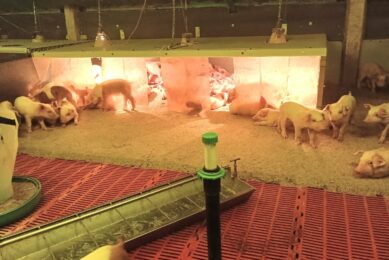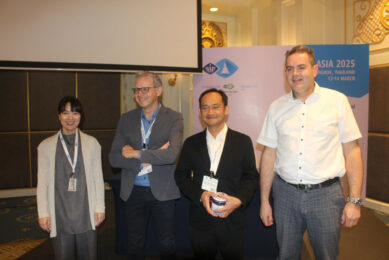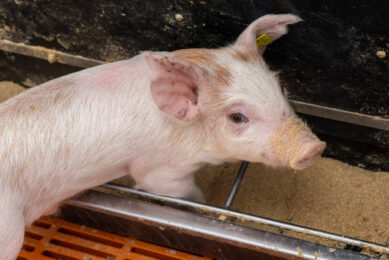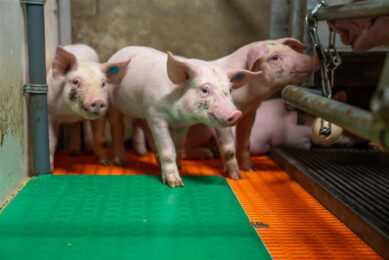Zero Zinc Summit: How to replace ZnO?
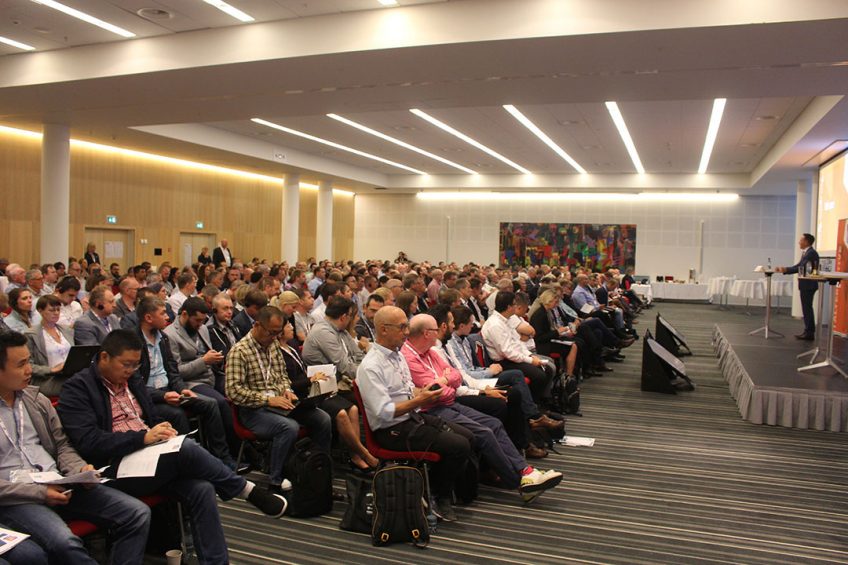
Veterinary and nutritionist experts from all over the world met in Copenhagen, Denmark, in late June 2019, for the first edition of the ‘Zero Zinc Summit’. Goal: figuring out best practices to get piglets through weaning without using antibiotics or pharmacological levels of zinc oxide. Pig Progress editor, Vincent ter Beek, summarised some practical take-aways.
In more than one way, the recently held Zero Zinc Summit could be called impressive. An event, held for the first time ever, instantaneously attracting 458 expert visitors from all over the planet, yes, that is quite a feat. On top of that, the event brought together high-level nutritionists and high-level veterinarians as well to talk about the same subject, something that doesn’t exactly happen at every technical meeting on pigs.
On the menu was the body part where both disciplines meet: the pig gut. To be more specific, it was the question of how to avoid diarrhoea with just-weaned piglets? The reason behind that question is simple: by 2022, in the European Union the use of pharmacological levels of zinc in pig feed will be banned. For a long time, providing high doses of zinc oxide (ZnO), was one of ways to control diarrhoea-related problems in just-weaned piglets. For environmental reasons, the European Commission banned the high-level usage of ZnO. Add that to the ongoing attempts to reduce the usage of antibiotics and it’s clear that Europe’s pig industry is back at square one. Currently, the toolbox appears empty.
New tools to control diarrhoea
But is it? Prof Charlotte Lauridsen of Aarhus University, Denmark, came closest to describing the situation in her keynote speech on feed additives: “There is probably not a single feed additive, which can replace ZnO for its capability to prevent diarrhoea. However, many potential feed additives share several of the mechanisms by which ZnO may influence the post-weaning diarrhoea (PWD) outcome.”
Her conclusion only applied to feed additives, but her line of thinking may actually be the key to an overall solution to overcome the problem of post-weaning diarrhoea. It is a multi-factorial problem and will therefore require a multi-factorial strategy as well. In that respect, a graph shown by Dr Nicolai Rosager Weber, of the Danish agricultural research institute SEGES, summed it up pretty well, see Figure 1. He subdivided causes for post-weaning diarrhoea into ‘predetermining factors’, ‘contributing factors’ and ‘determining factors’. This review takes his subdivision as a basis.
Figure 1 – Controlling post weaning diarrhoea – no common solutions.

Predetermining factors: Healthy piglets
Only a few speakers specifically focused on the ‘predetermining factors’. Veterinary keynote speaker Dr Fabien Larcher did though. As a vet with Selvet in France, he summed up a range of measures veterinarians could think of to avoid the occurrence of post-weaning diarrhoea. That included the issue of quality of the piglets at weaning. He specifically touched on hyperprolificacy, which in his view would lead to heterogeneity in the batch.
Also touching on piglet quality, was the contribution by Sangita Jalukar, speaking on behalf of Church and Dwight, manufacturing the product Celmanax, a yeast product which can be supplied to sow diets during lactation. She stated that piglets from sows that had received this additive, had finishing nursery weights that were not different from piglets on ZnO.

Themes like weaning age or genetics were not intensively discussed by any of the speakers.
Contributing factors: Feed ingredients
Not surprisingly, quite a lot of speakers presented their ideas and solutions would mostly deal with ‘contributing factors’ – the feed components. As Prof Alfons Jansman, Wageningen University, the Netherlands, revealed in his keynote speech, “Diet composition and nutrition strategies can help to reduce gut health problems in the period around weaning and support the functional development of the gut.”
In-feed protein levels play a role, of that Dr Niels Kjeldsen, SEGES, Denmark is convinced and the organisation has also adjusted its feeding recommendation. The Danish organisation now places it at 17.5% protein in phases 1 and 2, after trials showed that low protein reduced treatment days by 25%. Low protein, however, also means low productivity, he added.
Including the right fibres into the feed formulation also influences the question whether or not diarrhoea could occur. On behalf of Trouw Nutrition, Neil Jaworski tested the hypothesis that increased slow and resistant fibre would reduce the risk for post-weaning diarrhoea. He concluded saying that, “Specific fibre fermentation kinetics are critical in nursery pig gastro-intestinal tract development.”
An interesting presentation in this respect was held by Emma Suckling of Primary Diets, UK. Her company did a lot of studies on the inclusion of wheat bran to piglet diets. She presented data stating that addition of 4% wheat bran to diets increased feed intake, daily gain and improved FCR during the first 12 days post-weaning when zinc was not fed. She closed off, however, saying that there is still a growth performance gap which requires alternative management or nutritional interventions.

Interestingly, also from Trouw Nutrition, Jan Willem Resink brought in a new dimension to this debate, by stating that some pigs show a second dip in feed intake after weaning. His vision was that a too fast feed intake after weaning is not beneficial for the development of the intestines’ microflora.
Contributing factors: Feed additives
As mentioned above, Prof Lauridsen gave an excellent introduction into the different types of additives that could play a role in one way or another. Several speakers zoomed in on those in more detail.
The firm Schaumann of Germany is looking into zinc oxide itself – can that be made better? Saara Sander presented a novel technology enhancing zinc oxide by treating it in an eccentric vibrating mill. Calling the result ‘micronised zinc oxide’, the company says it increases the surface of zinc oxide particles, leading to higher product enthalpy and effectively reducing postweaning diarrhoea in piglets.
Paolo Trevisi of the University of Bologna, Italy, tested whether the bacteria Bacillus subtilis could lead to homeostasis in the pig’s gut. He concluded that that was the case. “Dietary supplementation with Bacillus subtilis DSM25841 may inhibit the effects of ETEC F4ac infection in weaned piglets,” he said, by improving gut health and the immune response, by reducing the Enterobacteriaceae in the caecum and by speeding up the post-infection villus growth.

Isoquinoline alkaloids from Macleaya cordata extract were the topic of a presentation by Sophie-Charlotte Wall of German-based company Phytobiotics. Having done various trials, she concluded that zinc oxide proved to be the most effective measure against post-weaning diarrhoea, but that isoquinoline alkaloids also significantly reduced the incidence of diarrhoea and the medication cost.
A trial at the Aristotle University of Thessaloniki, Greece, tested the efficacy of the blend Porcestin, a commercial tributyrin and glycerol monolaurate blend. Paschalis Fortomaris concluded that the blend had beneficial effects in replacing ZnO, and said that “such products could be considered as supportive means for the replacement of pharmacological levels of ZnO in piglets’ diets post-weaning.
Read more about the background of the Zero Zinc Summit in the interview with Lisbeth Shooter, of organising SEGES
Dr Marisol Castillo on behalf of Novus explained the mode of action and functioning of Provenia, protected benzoic acid feed. When used in piglets on commercial farms a reduction in medication costs could be noted as well as an improvement in performance, a better FCR and differences on biodiversity and composition in microbiota profiles.
Last but not least, Dr Casey Bradley, DSM explored the opportunities for a blend of benzoic acid, sodium butyrate and phosphoric acid. She concluded saying that “organic acid blends have potential value in replacing higher levels of zinc and copper with equal performance, but also have the ability to improve growth performance in programmes where higher levels of zinc are still allowed.”
Determining factors for post-weaning diarrhoea
In Figure 1, there was only one determining factor mentioned for post-weaning diarrhoea, and that is toxin-producing E. coli. Are there methods to directly overcome these?
On behalf of animal health company Elanco, Dr Frédéric Vangroenweghe explained more about Elanco’s Coliprotec, an oral vaccine that can be provided as from 18 days of age, offering protection against F4 and F18-positive E. coli. This vaccine, according to Dr Vangroenweghe, can reduce the incidence of moderate and severe E. coli post-weaning diarrhoea. In addition, it leads to a reduction of faecal excretion of F4-ETEC and F18-ETEC in piglets.
Obviously, that is not the only veterinary tool available. Dr Eric Cox of Ghent University, Belgium, explained how E. coli operate and gave an insight into the several intervention strategies available to veterinarians to combat E. coli, including e.g. the induction of innate immunity, vaccination and passive immunity. His conclusion, however, echoed the words of Prof Lauridsen: “There is currently no optimal alternative compared to antibiotics. Management combined with several other strategies are needed to control colibacillosis.”

Take home message
All in all, the major take-home message from the Zero Zinc Summit was that silver bullets do not exist, and relatively often the term ‘holistic approach’ was dropped. Finnish speaker Ina Toppari, ETT, could relate to all that. She presented the pig producing situation in Finland, which is already applying many of these aspects of the holistic approach. After all, the country has been working with stringent guidelines with regard to biosecurity, genetics, welfare and has long stopped using antimicrobials.
So all in all, the common notion has grown that, as long as antimicrobials and zinc oxide were used, many problems appeared not to exist, so factors mentioned in Figure 1 were not given a great deal of thought. Yet the factors were there all the time. The biggest gain of the Zero Zinc Summit is that it showed that the time has come to zoom in on each individual factor determining a healthy gut for just-weaned piglets – and ask ourselves what improvements can and should be made; solutions may vary from country to country and from farm to farm.
Side symposium at Zero Zinc Summit |



 Around the Zero Zinc Summit there were a number of side events. Prior to the ZZS, a roundtable organised by French potentiated zinc product manufacturer Animine, on June 17. The workshop presented three nutritionists who shared their views from Europe, Asia and Australia on how to reduce/eliminate pharmacological dosage of zinc oxide in piglet diets. Chaired by Daniel Brugger, Germany, the panel included Megan Edwards, Vietnam; Simon Tibble, Spain; and Steffen Hansen, Denmark.
Around the Zero Zinc Summit there were a number of side events. Prior to the ZZS, a roundtable organised by French potentiated zinc product manufacturer Animine, on June 17. The workshop presented three nutritionists who shared their views from Europe, Asia and Australia on how to reduce/eliminate pharmacological dosage of zinc oxide in piglet diets. Chaired by Daniel Brugger, Germany, the panel included Megan Edwards, Vietnam; Simon Tibble, Spain; and Steffen Hansen, Denmark. 